
Hope for a huge, ancient and imperilled fish
First Nations are leading efforts to make sure lake sturgeon can find a home in...
Tucked off the winding gravel highway in Nopiming Provincial Park, a faded wooden monument marks the site of the historic Irgon lithium mine. According to the sign, the site was drilled a couple dozen times in the 1950s; despite finding more than a million tonnes of ore, the market for lithium was dismal then and the site was quickly abandoned.
But some 70 years later, fortunes have changed.
Rusted metal and concrete slabs from the old mine are still embedded in the rocky valley, but the clear-cut trees and fluorescent flagging tape are new. The boreal forest that would have slowly reclaimed the land has been pushed back, the rocks have been cleared of lichen and distinct linear grooves of mineral sampling carve the landscape.

“This is the biggest intact forest left on the planet,” Wilderness Committee Manitoba director Eric Reder says, referring to Canada’s boreal forest. “We’re in the middle of as good as it gets in terms of nature, but we certainly don’t care for it here.”
A British Columbia-based mining company, Quantum Minerals Corporation, has been exploring the park for the last five years in hopes of eventually extracting what they estimate is $2 billion worth of lithium ore. Lithium, once used mainly to grease aircraft engines, is now a highly sought-after component of electric car batteries and other technologies deemed crucial to a low-carbon economy. Quantum Minerals has already moved in heavy machinery, felled trees and collected countless rock samples — and they’ve recently secured permits to expand even more.
Provincial parks may bring to mind swathes of protected wilderness, hiking trails, fishing holes and campsites nestled into the trees, but Manitoba’s parks system has always made room for industrial operations — like mining and logging — to co-exist with recreation and conservation.
But now the race for critical minerals is heating up, with companies expanding their search for the minerals deemed essential to a high-tech, low-carbon future. As the province heads to the polls and the Progressive Conservatives position themselves to capitalize on the province’s sought-after resources, Manitoba parks like Nopiming may not be as safeguarded as they seem.

These woods have been a second home to Reder for as long as he can remember.
He took his first canoe trip down the Manigotagan River in 1976, before the park had even been designated. He spent his childhood camping and fishing along the banks of Nopiming’s many lakes, learning to harvest wild rice, looking for pottery chunks and arrowheads that washed up on the shores.
He remembers being 14, driving the family pickup truck through the bush with his dad in the ’80s, and coming upon a swathe of clear-cut forest at the edge of their favourite fishing hole, Gem Lake.
“Gem Lake was the place that we took people to showcase Manitoba,” he says. “They had clear cut right to the shore and were logging inside the park and we thought: ‘How can this be?’ ”
In a way, this memory was the start of what would become a long career defending Manitoba’s parks from industrial operations. He always knew he would end up “talking about why Nopiming wasn’t being protected.” In the mid-aughts, he joined Winnipeg’s chapter of the Wilderness Committee to help with a campaign to stop commercial forestry in Manitoba parks. Two years later, he found himself leading both the campaign and the committee as its new director. Almost 15 years on, he’s still fighting to see Manitoba parks protected.

On a mild August morning, Reder powers his semi-converted camper van — complete with a canoe strapped to the roof rack — up the winding dirt road that carves north through Nopiming Park. He’s made this drive countless times, documenting the damage caused by mining and forestry inside park bounds.
When Nopiming — an Anishinaabe word meaning “gateway to the wilderness” — was designated a provincial park in 1976, it was intended to bridge the heavily trafficked Whiteshell Park on its southern edge to the vast wilderness of Atikaki Park farther north, and Ontario’s Woodland Caribou Park on the eastern border. The park comprises about 1,400 square kilometres of predominantly boreal forest and Canadian Shield. It is rich in spruce, pine and poplar woods; it contains more than 100 lakes, many of which sprout wild rice in the summers, and is peppered with marshes and bogs. Moose, black bears, wolves and a herd of threatened woodland caribou live in its woods. Parts of the park are located within the traditional territory of Sagkeeng First Nation, an Anicinabe Nation who have lived at or near the mouth of the nearby Winnipeg River for time immemorial.
Recreational developments have been limited to a handful of hiking and canoeing routes scattered within its borders, along with a few clusters of backcountry campsites, fishing boat launches, cottage communities and a couple of guest lodges. But Nopiming Park happens to lie in a rich mineral belt. Its northern reaches have been described as the cradle of gold mining in Manitoba, while its southern extents fall in the province’s most high-profile lithium belt. The only active lithium mine in Canada — the Tanco mine, owned by China-based Sinomine Resource Group — sits a stone’s throw outside the park border.

Because of those mineral deposits, mining has occurred in the park for over a century. The most up-to-date management guidelines for the park — written in 1988 — acknowledge “mineral exploration is currently widespread in Nopiming and vicinity” and warn new developments should be considered with an abundance of caution to avoid disrupting sensitive ecological systems. (Consultation on a new management plan was completed in 2014 and draft guidelines were written in 2015, but those guidelines are no longer publicly available and have not been finalized.) Despite that warning, new mineral claims are staked in the park every year. Less than 20 per cent of the park’s land area is protected from industrial activity; about 60 per cent of the land is earmarked for “resource management.” The rest is set aside for recreational development, though commercial resource extraction is still allowed. Today there are more than 300 active claims within the park’s borders.
The Irgon Site, Reder says, was once a thriving spruce wood. On the other side of the clear-cut area, the rocks are covered in spongy sphagnum moss, the air is cool, the trees drip with lichen and the boggy forest floor is covered in Labrador tea — it’s a sharp contrast to the struggling vegetation and decaying mounds of clear-cut trees in the mineral exploration area.
“I don’t know why they needed to bulldoze this piece of forest,” Reder laments. “How many decades will it take for this to be more than a scar?”
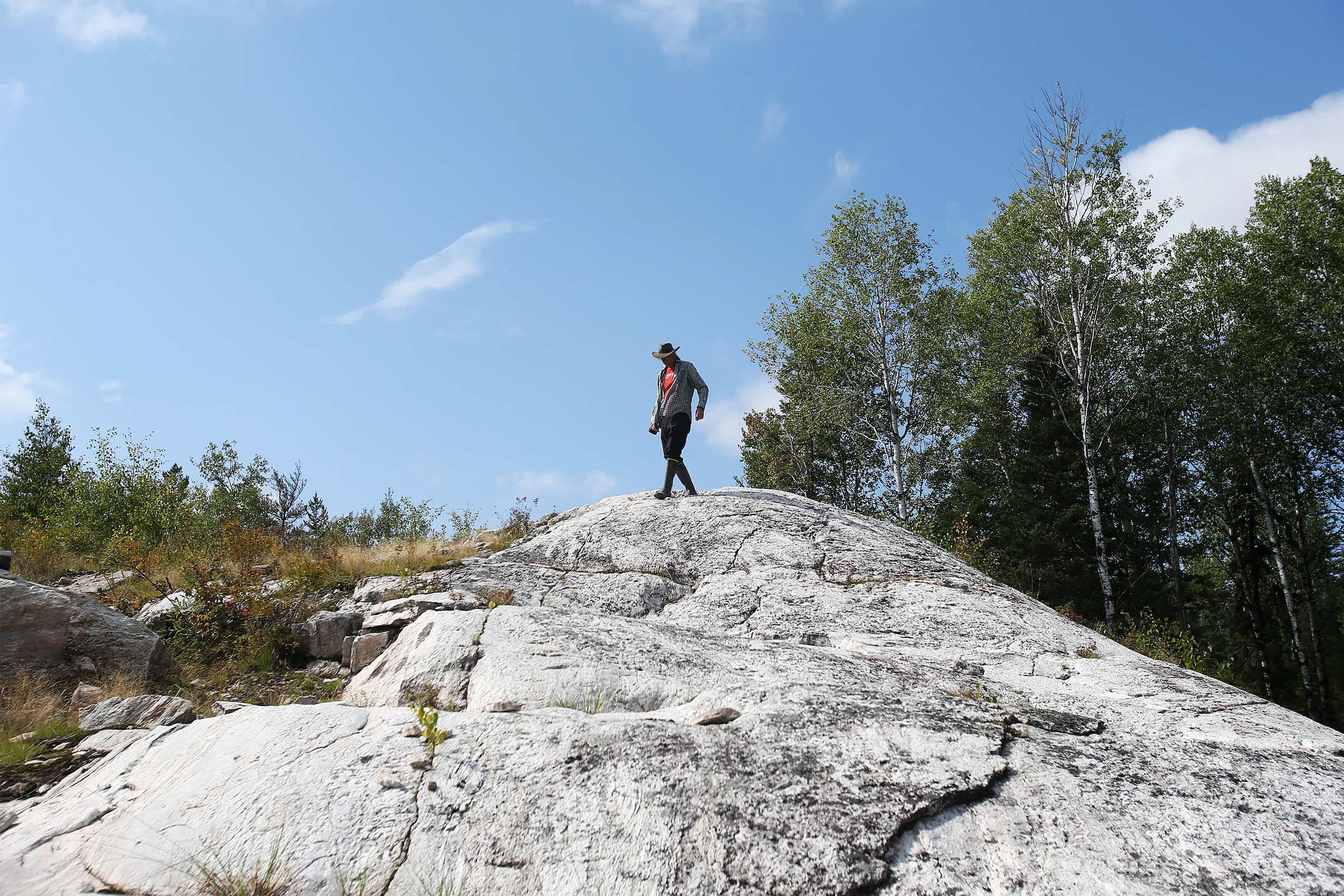


Mining has always been allowed in Manitoba parks. Logging was too, until Reder and the Wilderness Committee secured a ban on forestry in all but one provincial park in 2009. When the Provincial Parks Act came into force in 1960, the idea was to formally designate commonly used recreation areas as parklands while respecting the existing mining, logging and agriculture projects that fell within park boundaries.
It would take decades for the government to incorporate conservation and wildlife management into its parks strategy, and even then, the province worked to make sure industrial activity, recreation and conservation could co-exist.

“The Manitoba Provincial Parks Act and associated regulations such as the Park Activities Regulation strictly regulate what is permitted within Manitoba’s provincial parks to ensure that present and future mining activities across the province are conducted in ways that are environmentally sustainable,” an unnamed provincial spokesperson said in an emailed statement.
The trick was to create management plans for Manitoba parks and divvy up the land into different use categories. Development is banned on lands designated as backcountry and wilderness areas, as well as in some heritage areas; lands designated for recreational development or “access” can sometimes be opened to resource projects (many access lands are used for hydroelectric infrastructure) and lands designated as “resource management” have been set aside for commercial extraction.
Jamie Kneen, co-lead of Mining Watch Canada, a non-governmental organization advocating for increased oversight of the industry, says that approach has led to “gerrymandered parks,” where boundary lines don’t follow the ecological priorities of the area.
In Nopiming, for example, provincial documents show sensitive caribou habitat overlaps with resource extraction zones.
“The mining industry has had a very active say in where the park boundaries go so that areas of strong mineral potential are excluded from the designation,” he says.
MaryAnn Mihychuk, president of the Manitoba Prospectors and Developers Association, calls it a “more progressive” approach to conservation and ecological protection.
Mihychuk is both a longtime mining professional and a former politician, serving as a member of Manitoba’s legislative assembly from 1995 to 2004 and as the NDP government’s minister of mines from 1999 to 2003, before a stint as a federal Liberal member of parliament. Shortly before her time in provincial office, Canada signed on to the first global conservation targets, a 1992 push to protect 12 per cent of lands from development.

In the early 2000s, she says, mineral companies were asked for input as the provincial government began to develop its network of protected areas.
“Government would say ‘We intend to block this whole area,’ and the companies would try to argue ‘This looks like a mineral belt extension, it could potentially be detrimental, are we sure we want to do that?’ ” she explains. “The industry would never say ‘We want to protect this area from ourselves.’ ”
Today, 22 of Manitoba’s 93 provincial parks are permanently and wholly protected from development, according to analysis by the Winnipeg Free Press and The Narwhal. The remainder are either mixed-use, like Nopiming, or not protected at all.
The fully protected parks make up nearly 70 per cent of Manitoba’s parks by land area — they comprise 30,000 square kilometres of predominantly northern boreal forest, about the size of Vancouver Island.
But the mineral industry is on a mission to access, explore and develop as much minerally rich land as possible, and it sees Manitoba parks and protected areas as standing in its way. Ten per cent of all park lands are open to industrial activity — that’s 4,700 square kilometres, ten times the size of Winnipeg — but the industry wants more.

“We are now in an existential threat to Earth, and our mission — all of us — is to find a way to the new green economy as fast as possible,” Mihychuk says, referring to the minerals deemed critical to lower-carbon electrification and battery technologies.
“Our association is saying it is time to suspend all protected areas and allow exploration to happen in those areas, with the permission of Indigenous Peoples whose land it is.”
During debate in the legislature in the spring of 2014, then-NDP environment minister Gord Mackintosh was asked, point blank, whether he was looking into the possibility of removing mining from provincial parks.
“The hundreds of millions of dollars that would be required to expropriate the mining interests from our parks would really not withstand the support of Manitoba taxpayers,” Mackintosh replied. “While we would like to address the issue in some way, it won't be through the wholesale ending of mining interests in parks. That's just not on; that's just not possible.”
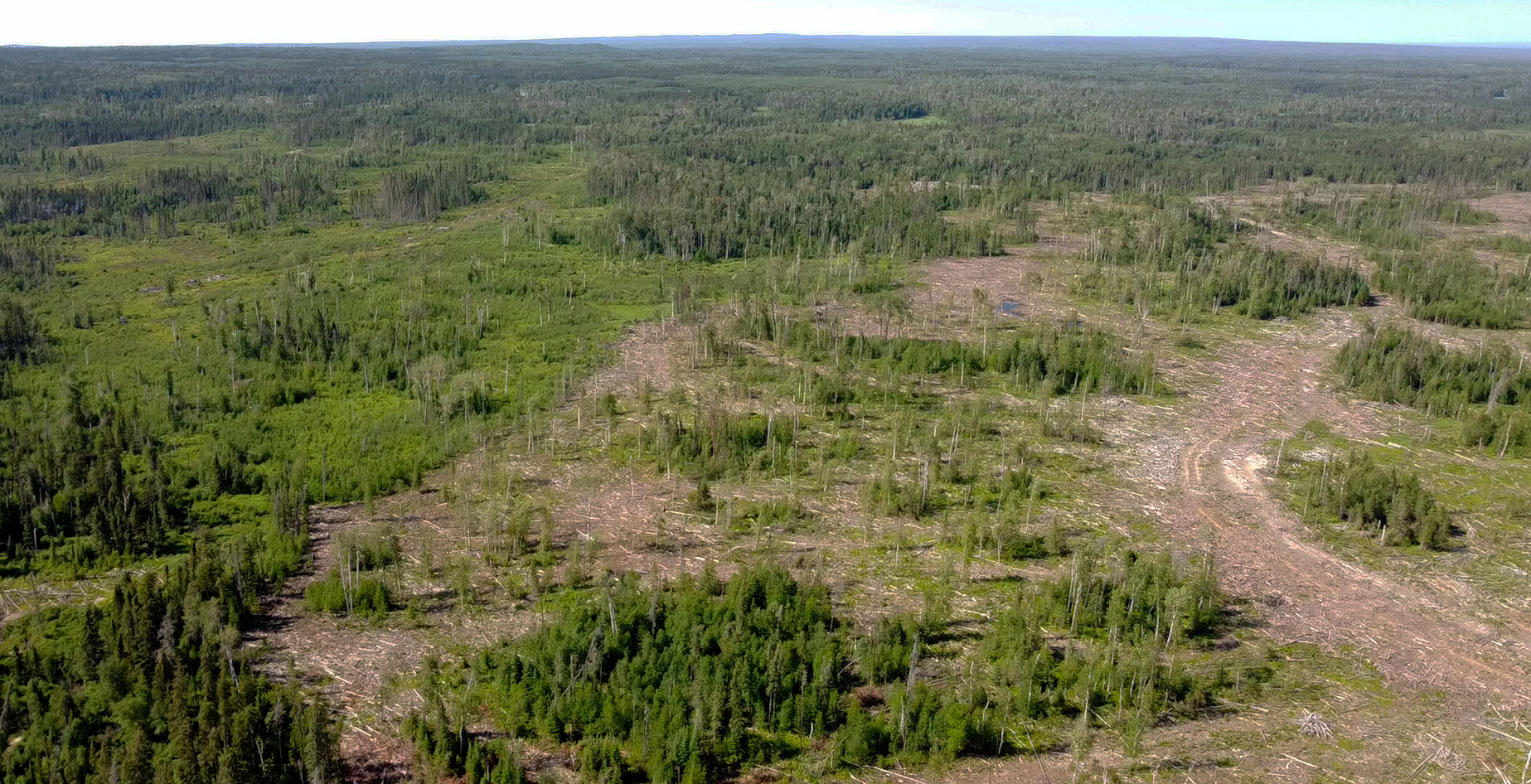
Manitoba paid a combined $3 million to buy two forestry companies out of their licences to log provincial parks. Making such a payment to cover the 1,600 mining claims in parks at the time seemed too steep a price. Mackintosh claimed Manitoba’s parks were “unique” because many were designated in areas where mining interests predated park development. In reality, that’s not unique at all.
Most provincial park legislation across the country was developed at a time when mineral exploration and commercial forestry already had a stronghold on the land and economy, so allowances for resource extraction were built into the laws nation wide. Only national parks have always banned resource extraction.
But as the United Nations Convention on Biological Diversity began to emphasize the importance of conservation to combat rising levels of carbon pollution, setting progressively more ambitious targets for protected areas, many provinces began slowly phasing out industrial activities in their parks. Logging has been banned in all provincial parks except Algonquin in Ontario and Duck Mountain in western Manitoba.

British Columbia, Alberta and Ontario have banned new resource extraction projects in provincial parks. Alberta is managing a number of pre-existing oil and gas projects still operating in its provincial parks, but has outright banned open-pit mining. Ontario has banned all industrial activity in parks aside from forestry and gravel pits in Algonquin and a handful of pre-existing oil wells. Industrial activities are banned outright in parks in Quebec, New Brunswick and Newfoundland and Labrador.
Manitoba, paradoxically, is leaning in the other direction. Not only are new mining projects still being approved in provincial parks, the government has provided grants to several out-of-province companies to support exploration activities happening inside park lines. The Manitoba Mineral Development Fund, an annual government fund managed by the Manitoba Chamber of Commerce, disbursed more than $750,000 in 2021 and 2022 to companies working on mineral exploration projects in Grass River and Nopiming, according to analysis from the Winnipeg Free Press and The Narwhal. Several of these companies have been granted further funding in 2023.

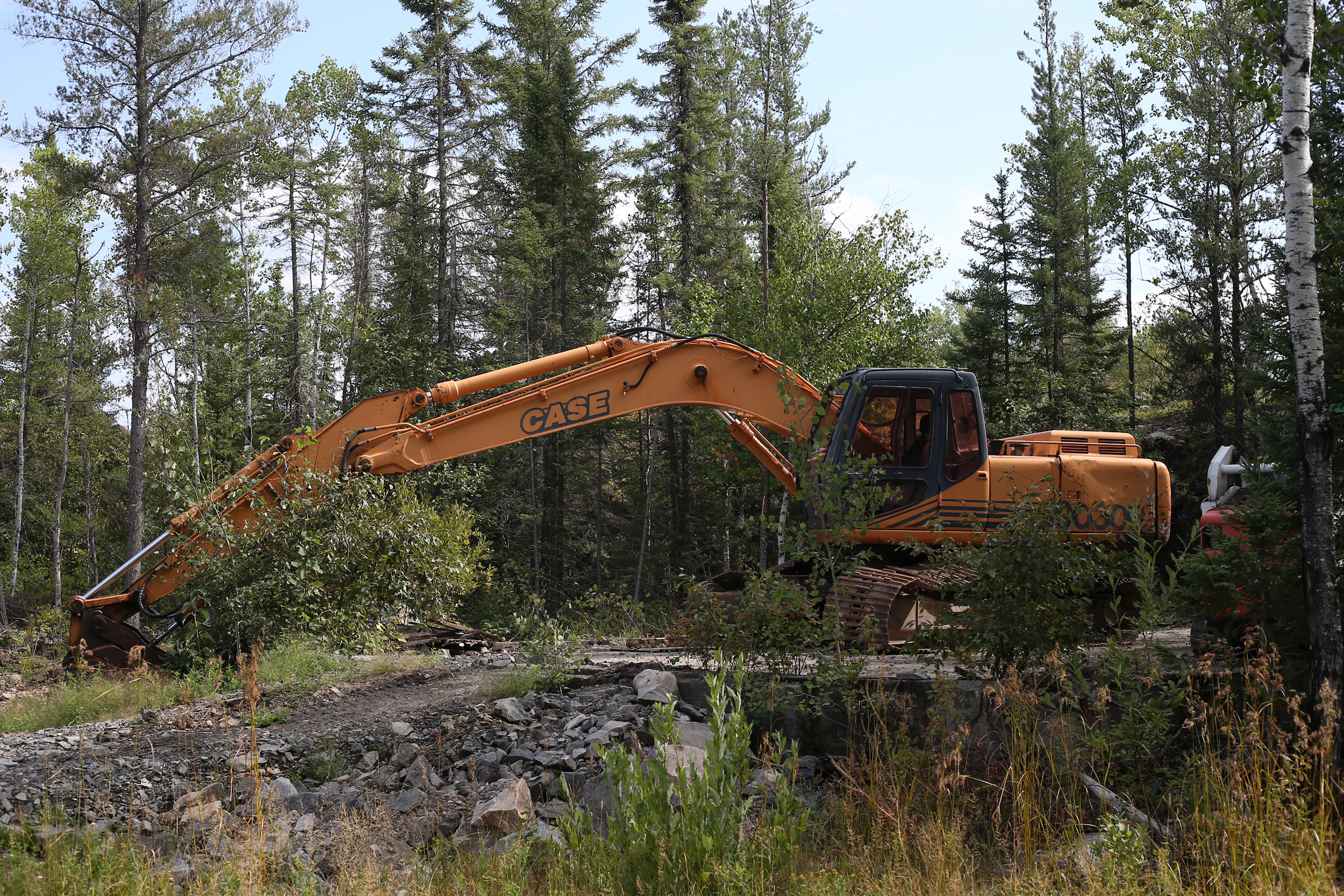
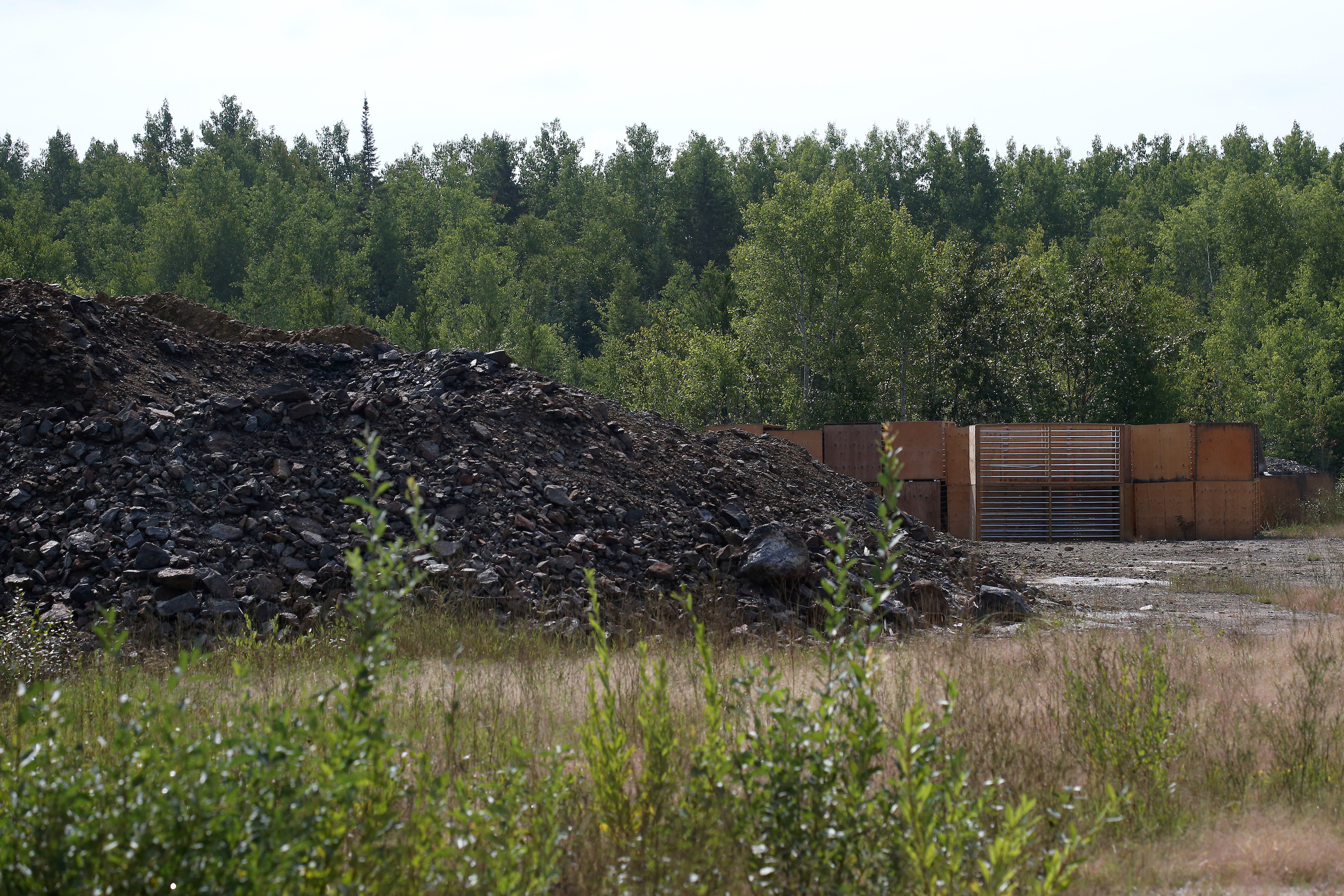
The race to mine critical minerals — considered the building blocks of a green economy — has seen Manitoba ramp up investment in its mining industry at the expense of conservation.
“The mining industry and government are using this as an excuse to build up industrial development without addressing the kind of changes that are really needed and which would have huge benefits to the climate and just to the liveability of society,” Kneen says.
“The bottom line is many of these things are incompatible.”
It’s late July, and Larry Lee has just spent his morning stacking two cords of wood with a neighbour in the small cottage community near Flanders Lake, on the east side of Nopiming Park, where he’s lived since 2008.
“We were raised in small towns with lots of community spirit and we find that living out here … everybody looks out for each other,” Lee says on a phone call.
“It’s serene, peaceful, lots of wildlife. We have moose coming up to our back door, river otters on our dock. The flora and fauna are beautiful. The greenery, the wild blueberries, I could go on. It’s a very peaceful life.”

There have been mining claims in the area for as long as Lee can remember, but lately, with lithium and other minerals in high demand, exploration is starting to pick up speed.
Lee says he has seen prospectors (the ones he’s spoken to come from Kenora and Thunder Bay) carving through trails on all-terrain vehicles and staking claims in the bush. Traffic on the poorly maintained park roads has gotten heavier, with more trucks hauling flatbed trailers loaded with bulldozers and other large machines. He worries the extra traffic will be dangerous for park visitors and exploration will scare away the vibrant wildlife community.
Retired biologist Doug Collicutt echoes those concerns. He has a cottage in Whiteshell Provincial Park — one of Manitoba’s most beloved recreational spots — and has watched as exploration companies enter, destroy and then leave Manitoba parks. In his neck of the woods, near Star Lake, the government has spent untold funds remediating the now-derelict gold mines scattered around the park, but exploration continues.
"I've been frustrated for 25 years,” Collicutt says. "We don't want commercial exploitation and industrial development in our backyard."
Near Nopiming, Lee feels the same. “It’s the serenity and peacefulness that attracted us, when that is broken by having to be concerned about transportation issues or potential mineral development, it’s breaking our way of life,” Lee says.
According to Mihychuk, mineral exploration has a very small environmental footprint.
Prospectors start by reviewing maps and historic records to identify areas where mineral deposits may be buried. From there, she explains, companies use drones to survey the land from above. When a company thinks it may have found a deposit, it can apply for a mineral disposition (better known as a mining claim).
These claims aren’t particularly difficult to attain: anyone 18 and older can get a prospector’s licence online for $15 and stake a claim for less than $70. Fees for companies seeking a license are higher, starting at $287.
From there, prospectors bulldoze cut lines in the bush, mark the edges of the claim with wooden posts and begin digging trenches or grooves to sample the rocks. If they find something promising, they apply for a permit to start clearing vegetation for drilling. According to Mihychuk, the biggest a drilling operation gets is the size of two motorhomes. Once exploratory drilling is over, she says, the company cleans everything up.
Not everyone agrees. “The problem is that it’s not really that low impact,” Kneen says.
At the Irgon Site, exploration involved clearing an 800-metre stretch of forest, piling felled trees in heaps and leaving clearings full of discarded machinery and shipping containers.

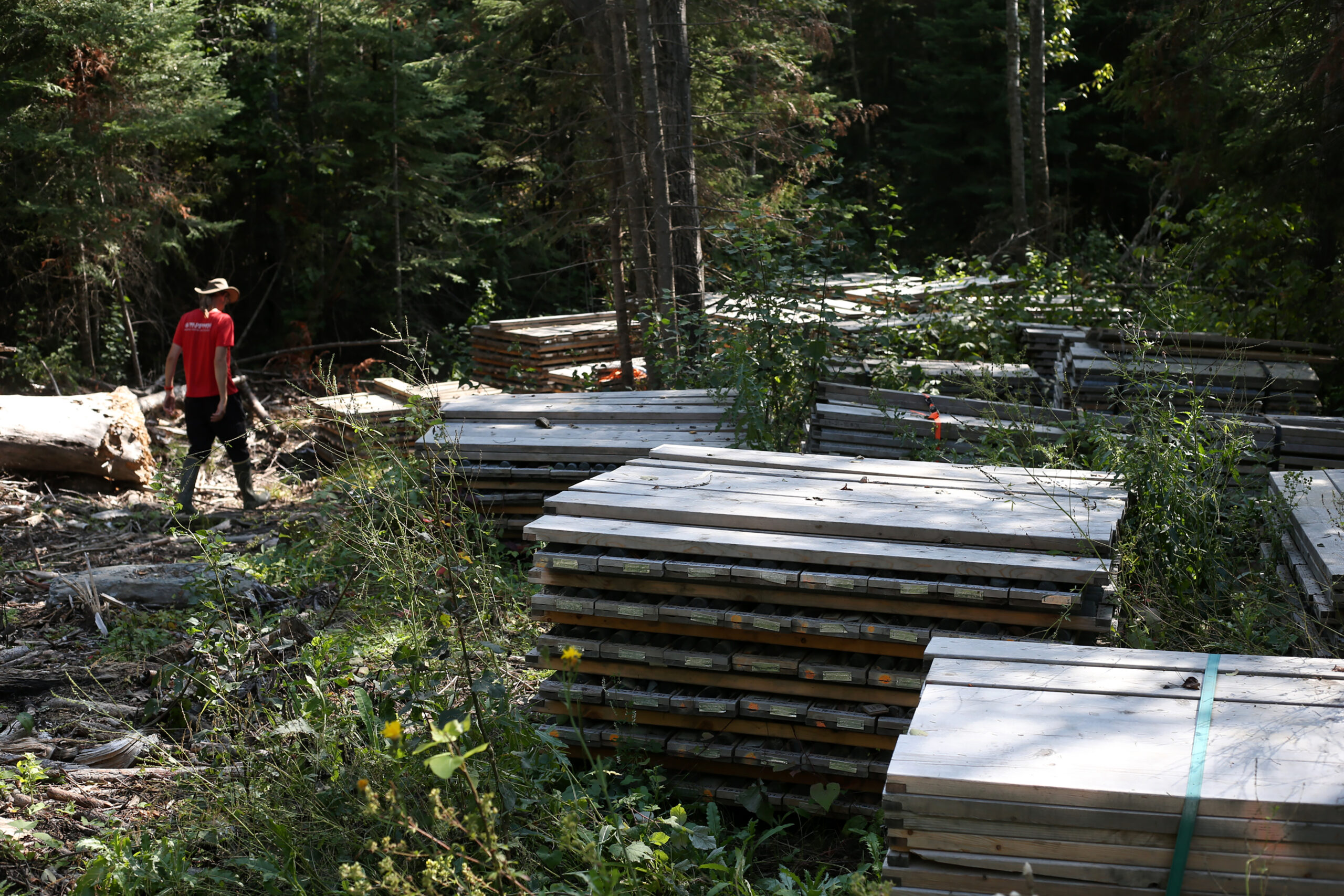

Deeper in the park, across the road from sensitive moose habitat, another mining company has left more than a dozen pallets of unprotected lithium ore samples in a clearing for at least two years. Labels on the pallets show the samples belong to New Age Metals lithium exploration projects, which received grants from the Manitoba Mineral Development Fund in 2022 and 2023, and has just announced a $7-million exploration project in partnership with Australian lithium producer Mineral Resources Ltd.
Logging and mining access roads have been bulldozed throughout the park, creating what are known as linear disturbances that open wildlife up to more predation by cutting unnatural sight lines through the dense refuge of the forest leaving prey animals fewer places to hide.
Just five minutes past the park welcome sign at the south entrance, yet another company has set up shop in an old gravel pit, leaving heaps of waste rock to leach minerals into the soil and groundwater.
“When you’ve created piles of toxic waste, they don’t go away,” Kneen says.
Prospecting and exploration are not typically monitored or inspected. Mihychuk describes the industry as “sort of unrestricted.” All a company needs to start work is a permit from the parks branch, and the province’s limited environmental monitoring resources are typically put towards larger projects like active mines.
Legislation does not require residents like Lee and local First Nations to be notified when new exploration projects start. The Free Press and The Narwhal reached out to members of Sagkeeng First Nation and other Indigenous leaders for comment on industrial activities in Nopiming and other provincial parks, but did not receive a response by publication time.

“Nobody tells us: ‘You’re going to have a team of people in your area making claims,’ ” Lee says. “The communication from the province has been nothing.”
Reder says the lack of communication contributes to a lack of accountability.
“If we, as the public, want to find out what's happening here inside our public provincial park, there are no signs to tell us who's here, we don't know what's occurring here, we don't know the name of the company, we don't have a phone number to call to ask,” he says.
“We just show up and there's more destruction in the park.”
Right now, there are no operational mines inside Manitoba parks, just exploratory projects. But Mihychuk says: “You can develop a mine in a park in Manitoba. And it was done.”
In 2013, Hudbay Minerals, a longstanding Manitoba mining titan (and one of Mihychuk’s former employers), found a small copper deposit inside Grass River, a 2,300-square-kilometre provincial park about 75 kilometres north of The Pas. The park is fairly remote — it would take at least seven hours to drive there from Winnipeg — and was designated in part to protect a sensitive herd of caribou that live and calve along its many lakes. But Grass River is another mixed-use park; 75 per cent of the land is categorized for resource extraction while just one per cent is protected.



By the time Hudbay applied for an environment act licence to develop an underground mine near Reed Lake, which is a caribou calving area, they had already started drilling, building infrastructure and extracting 10,000 tonnes of ore — the equivalent of nearly 800 large dump truck loads — under the banner of advanced exploration.
The Wilderness Committee led a campaign opposing further development of the mine, arguing the site was too close to sensitive caribou habitat and shouldn’t be within park boundaries at all, but there was little they could do.
“At the point when they were asking for public opinion, they’d already built the mine,” he says.

Manitoba granted Hudbay the licence, added a clause the company would need to actively participate in caribou monitoring in the area and promised the government would review its policy on mining in provincial parks. The review has not yet been completed, according to the province.
Five years of extraction later, the mine was closed and remediation efforts were underway.
“You would never know it was there,” Mihychuk says.
But Reder says the open gravel patch is still a scar on the park. The adjacent access roads still leave unnatural sightlines for predators hunting moose and endangered caribou. It will take many years for the forest to reclaim the mine — even though the company scarified the soil for revegetation — and that’s provided there aren’t toxic materials lingering in the groundwater like there are at Hudbay’s decommissioned Spruce Point mine, farther inside the park.
Reder collected and tested water samples from Spruce Point in 2014; the results showed high concentrations of 11 toxic substances, including nickel and copper, in the bog water. Reder says the province never took his test results seriously. The company has attributed the dirty water to 1980s mining practices, where waste rock from the mines was used to build access roads, sometimes causing acid rock drainage when the metals were exposed to air and water. Hudbay claimed it tested the drainage at the Spruce Point site and found it was merely “unattractive,” and presented “no risk to the water bodies in the local environment.” A provincial spokesperson said the environmental compliance branch last visited the site in 2018 and found nothing of concern.
The legacies of mineral exploration and development in Manitoba parks paint a picture of a province valuing economic development over its natural assets.
The province has already been clear it will do whatever it can to bolster its critical mineral industry in the years to come, providing grants, tax breaks and other incentives to mining companies while reducing regulatory “red tape.”
Mihychuk scoffs at the idea of protecting 30 per cent of the province’s lands and waters by 2030 — the United Nations’ most recent conservation target, signed by over 190 countries, including Canada — arguing “now is not the time to pick big areas and sterilize them from exploration.” The province, accordingly, hasn’t added more than a few square kilometres to its protected areas network in seven years, according to an analysis by The Narwhal and the Winnipeg Free Press.
The prospecting industry has been asking government to go a step further and suspend protected areas entirely while they hunt for critical minerals.

But to most Manitobans, the idea of resource extraction in the parks they camp, fish, hunt and play in is appalling. A Probe Research poll commissioned by the Wilderness Committee in 2018 found 70 per cent of Manitobans supported a ban on industrial activities in provincial parks.
“I’m not against business. I’m not against making good use of what’s available for our province. That said, I think boundaries need to be used and kept,” Lee says.
Oftentimes, the tensions between protected areas and industrial developments are framed in terms of economics — mining can be a major economic driver and politicians emphasize the need for economic growth. But at MiningWatch, Kneen says there’s also room to talk about the economic value of Manitoba parks and protected areas.
The World Bank, United Nations and International Union for Conservation of Nature have released reports suggesting parks and protected areas can generate significant returns on every dollar invested.
Beyond the direct revenue from tourism, there’s value to preserving clean air, clean water, healthy forests and recreation space.

Kneen says governments should “not blink when it comes to imposing the most stringent environmental and social restrictions on [industrial] operations because those impacts will be there for a long time.”
Mining and resource extraction won’t disappear, but Reder stresses there are “middle-of-the-road” solutions that can ensure extraction is environmentally responsible.
It starts, he says, with appointing a minister responsible for liaising with Indigenous communities and gathering knowledge about the ecological, cultural and spiritual values of their lands. Land use planning should be led by Indigenous Knowledge and managed by Indigenous communities, he adds.
Mihychuk stresses that’s the direction she hopes to see protected areas go in the future.
Where there is mineral exploration, Reder says the “cowboy” tactics — unregulated claim-staking, exploration and abandonment — should be eliminated in favour of transparency, accountability and governmental oversight.
“If we need lithium that badly, then the Province of Manitoba can pull it out of the ground, take on the responsibility, burden and profit, and do it with the appropriate safeguards in place,” Reder says.
“And if you absolutely need this mineral, show me three times as much space that you’re going to protect elsewhere.”
Get the inside scoop on The Narwhal’s environment and climate reporting by signing up for our free newsletter. Angello Johnson’s shoulders burn, and his arms...
Continue reading
First Nations are leading efforts to make sure lake sturgeon can find a home in...

We’re excited to share that an investigation by The Narwhal is a finalist for the...

A new documentary, Nechako: It Will Be a Big River Again, dives into how two...
